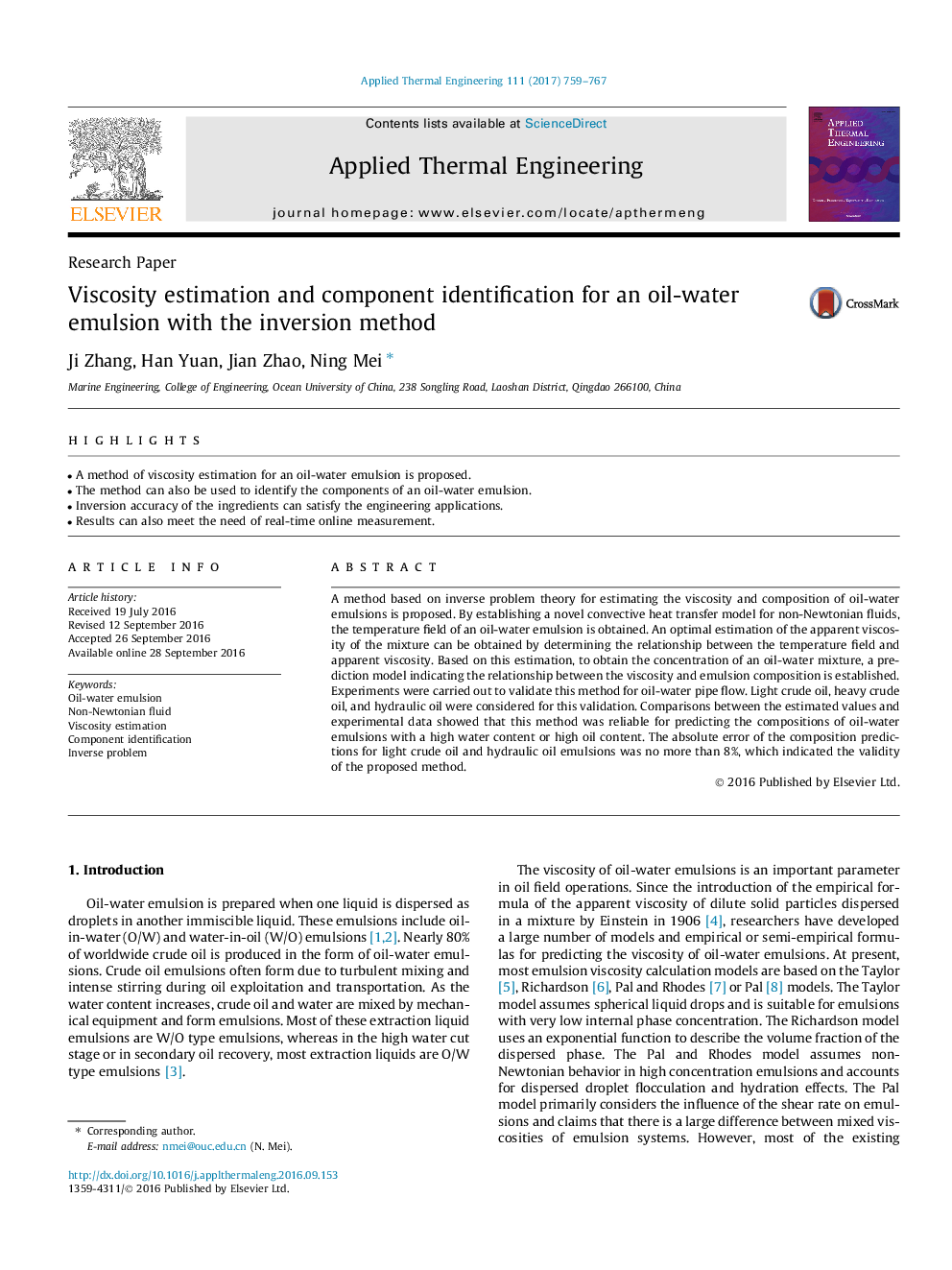| کد مقاله | کد نشریه | سال انتشار | مقاله انگلیسی | نسخه تمام متن |
|---|---|---|---|---|
| 4992158 | 1457118 | 2017 | 9 صفحه PDF | دانلود رایگان |
عنوان انگلیسی مقاله ISI
Viscosity estimation and component identification for an oil-water emulsion with the inversion method
ترجمه فارسی عنوان
برآورد ویسکوزیته و شناسایی مولفه برای یک امولسیون نفت آب با روش معکوس
دانلود مقاله + سفارش ترجمه
دانلود مقاله ISI انگلیسی
رایگان برای ایرانیان
کلمات کلیدی
امولسیون نفت و آب، مایع غیر نیوتنی، برآورد ویسکوزیته، شناسایی جزء، مشکل معکوس
ترجمه چکیده
یک روش مبتنی بر نظریه معکوس معکوس برای تخمین ویسکوزیته و ترکیب امولسیون های آب-نفت پیشنهاد شده است. با ایجاد یک مدل جدید انتقال حرارت کنونی برای مایعات غیر نیوتنی، دمای دما یک امولسیون آب-نفت بدست می آید. برآورد مطلوب ویسکوزیته ظاهری مخلوط را می توان با تعیین رابطه بین دمای دما و ویسکوزیته ظاهری بدست آورد. بر اساس این برآورد، برای به دست آوردن غلظت یک مخلوط نفت و آب، یک مدل پیش بینی نشان می دهد که رابطه بین ویسکوزیته و ترکیب امولسیون ایجاد شده است. آزمایش ها برای اعتبارسنجی این روش برای جریان لوله نفت و آب انجام شد. نفت خام سبک، نفت خام سنگین و روغن هیدرولیک برای این اعتبار سنجی مورد توجه قرار گرفت. مقایسات بین مقادیر برآورد شده و داده های تجربی نشان داد که این روش برای پیش بینی ترکیبات امولسیون های نفت آب با محتوای آب بالا و یا محتوای بالای روغن قابل اعتماد است. خطای مطلق پیش بینی های ترکیب نفت خام سبک و امولسیون روغن هیدرولیکی بیش از 8٪ نبود، که اعتبار روش پیشنهادی را نشان می داد.
موضوعات مرتبط
مهندسی و علوم پایه
مهندسی شیمی
جریان سیال و فرایندهای انتقال
چکیده انگلیسی
A method based on inverse problem theory for estimating the viscosity and composition of oil-water emulsions is proposed. By establishing a novel convective heat transfer model for non-Newtonian fluids, the temperature field of an oil-water emulsion is obtained. An optimal estimation of the apparent viscosity of the mixture can be obtained by determining the relationship between the temperature field and apparent viscosity. Based on this estimation, to obtain the concentration of an oil-water mixture, a prediction model indicating the relationship between the viscosity and emulsion composition is established. Experiments were carried out to validate this method for oil-water pipe flow. Light crude oil, heavy crude oil, and hydraulic oil were considered for this validation. Comparisons between the estimated values and experimental data showed that this method was reliable for predicting the compositions of oil-water emulsions with a high water content or high oil content. The absolute error of the composition predictions for light crude oil and hydraulic oil emulsions was no more than 8%, which indicated the validity of the proposed method.
ناشر
Database: Elsevier - ScienceDirect (ساینس دایرکت)
Journal: Applied Thermal Engineering - Volume 111, 25 January 2017, Pages 759-767
Journal: Applied Thermal Engineering - Volume 111, 25 January 2017, Pages 759-767
نویسندگان
Ji Zhang, Han Yuan, Jian Zhao, Ning Mei,
